
Storms in Northwest cause difficulties
While winter snow normally generates images of crystal white landscapes and holiday cheer, winters in the national parks of the Pacific Northwest have been anything but cheerful in the last couple years.
Many of the nation’s parks in the region have had gifts of beautiful holiday weather replaced by flooded roads, fallen trees and millions of dollars worth of property and facilities damage.
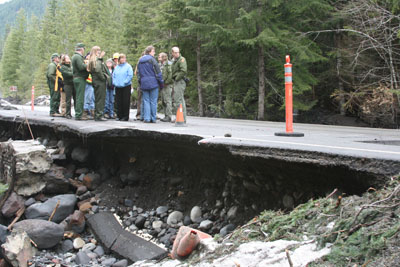 |
Kautz Creek, in its new channel, has repeatedly flooded the park road, causing severe erosion at Mount Rainier National Park (Photo courtesy of National Park Service). |
Since 2006, more than $40 million has been spent on damage repair in Mount Rainier, Olympic, and North Cascades national parks in Washington due to the increasing severity of winter storms that plague the region each year.
“The storms that have been affecting the national parks are unusual in intensity and the amount of rain that has fallen,” said David Graves, Northwest field representative for the National Parks Conservation Association.
In late 2006, Mount Rainier National Park suffered from storm damage in every part of the park, costing the national park system more than $36 million in damage. The damage was so severe that the park was forced to close to the public for six months to repair roadways, campgrounds, and clear up the fallen trees before reopening in May 2007.
“There has been tremendous damage. Every road in the park had wash outs, campsites were washed out, rivers started to change course. For the first time in 50 years or so, the park was completely closed,” Graves said.
“During that time, they were trying to fix a lot of the roads and the park wasn’t entirely restored until the end of 2007. On top of that, Olympic National Park was hit really hard this past December. A lot of roads washed out and there were mudslides. They are still working to fix a lot of those areas,” Graves continued.
| Elwha River floodwaters cover campsites at the Altair Campground in Olympic National Park (Photo courtesy of National Park Service). |
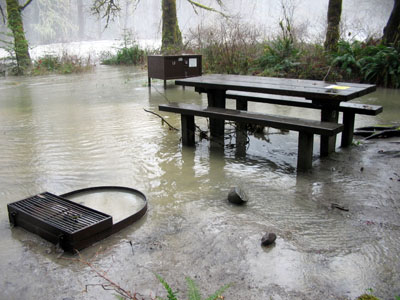 |
While the cost in damage at Olympic has been estimated at $5 million, Mount Rainier experienced minimal damage during the storms in December 2007.
Despite the extended closure at Mount Rainier, the park is still recovering from the 2006 storm. According to park officials, it will not be until the end of next summer before recovery will be completed. One of the campgrounds still needs to be recovered and several sections of a trail are still damaged.
According to experts, the Pacific Northwest normally experiences very wet winters each year. It snows at high elevations, while it rains in lower elevations. During an average year, the region will receive about 640 inches of snow and 900 inches of rain, said Lee Taylor, chief of Interpretation and Education at Mount Rainier National Park.
“It’s obviously a very rainy time of year,” Taylor said. “The [2006] storm event was unique in the way that it rained for 36 hours straight.” Approximately 18 inches of rain fell during that time period during above freezing temperatures. The storm ultimately caused flooding since a large amount of rain fell in a very short and warm period of time, which was described as rain falling on snow.
“While flooding is not at all uncommon at that time of year, there is a trend where they are getting progressively worse,” Taylor continued. “We have many places in the park where the road is lower in elevation than the river. Since the river is above the roads, the roads are more impacted during flooding.”
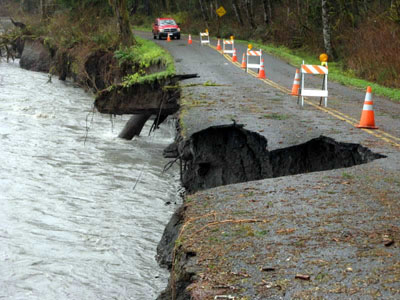 |
Damage to the Hoh Road in Jefferson County, outside the Olympic National Park boundary (Photo courtesy of National Park Service). |
With the storms increasing in intensity, experts are still unsure as to whether wildlife is being affected by the damage. According to officials, research has not been conducted in the area as of yet.
“Wildlife is probably not being affected in a measurable way, since most of the plant and animal community are resilient, so a storm event like this is just part of the natural order of things,” Taylor said.
However, the national parks in the Pacific Northwest are not the only ones that have been affected by storms in recent years. According to the National Parks Conservation Association, the storms in 2004 caused over $50 million to the national parks system.
At Florida’s Canaveral National Seashore, more than 1000 sea turtle nests were wiped out due to Hurricanes Frances and Jeanne, while also damaging the homes of several endangered species.
The NPCA online article also mentioned that “heavy storms in Virginia and North Carolina, brought on by hurricanes Frances, Ivan, and Jeanne, caused landslides that closed portions of the 470-mile Blue Ridge Parkway,” which impacted visitation. The Great Smoky Mountains National Park, one of the system’s most-visited locations, also experienced close to $3 million in hurricane damage.
Because of the increase in storm severity and cost of damage, experts are now trying to figure out ways to prevent such widespread damage during a storm event. According to Taylor, roads and levees at Mount Rainier are being rebuilt to sustain floods, while protection is being built around rivers.
At North Cascades National Park, officials are working on a plan to move structures so that the Stehekin River will have its natural flood zone, which will allow the river to act naturally.
| Thousands of trees were blown down by winds in the Quinault Valley at Olympic National Park (Photo courtesy of National Park Service). |
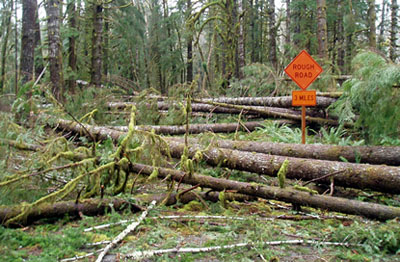 |
“We are now in the process of compiling these public comments and developing a range of alternative actions. These alternatives for how we will manage the river system, the adjacent road system and the many homes and properties in the flood zone will encompass a range of possibilities,” said Kerry Olson, Stehekin district interpreter for North Cascades National Park, in an e-mail message.
“Some of these alternatives would allow the river to utilize and move within its natural flood zone. However, some of the alternatives protect the current road system and surrounding areas by more actively managing the river,” Olson added. “Other parks in the area are also facing the same issue because flooding of their rivers are creating the same kinds of issues. We are the only ones who have started this process that I am aware of, but each park site will have an independent set of criteria and constraints.”
Graves also said that a conference is being planned for the near future, with members of the U.S. Congress and experts to discuss the likelihood of storms increasing in severity in upcoming years.
“Scientists have seen more intense and heavy rainfalls, so to prevent damage we need to look at longer term preparations,” Graves said.
“One way that we can change is to adapt to change.”
| A picnic table is lost in the logjam downstream from Ohanapecosh at Mount Rainier National Park (Photo courtesy of National Park Service). |
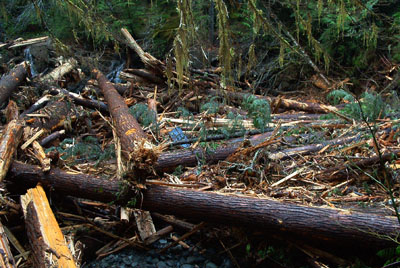 |
For Additional Online Information
- National Park Service at http://www.nps.gov
- National Park Service Nature and Science at http://www.nature.nps.gov
- National Parks Conservation Association at http://www.npca.org
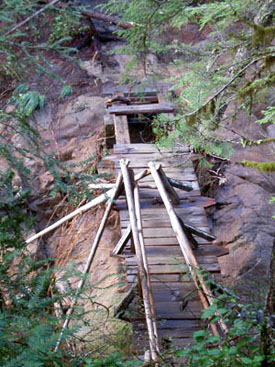 |
The new Silver Falls bridge was heavily damaged by the flood at Mount Rainier National Park (Photo courtesy of National Park Service). |

Comments are Closed